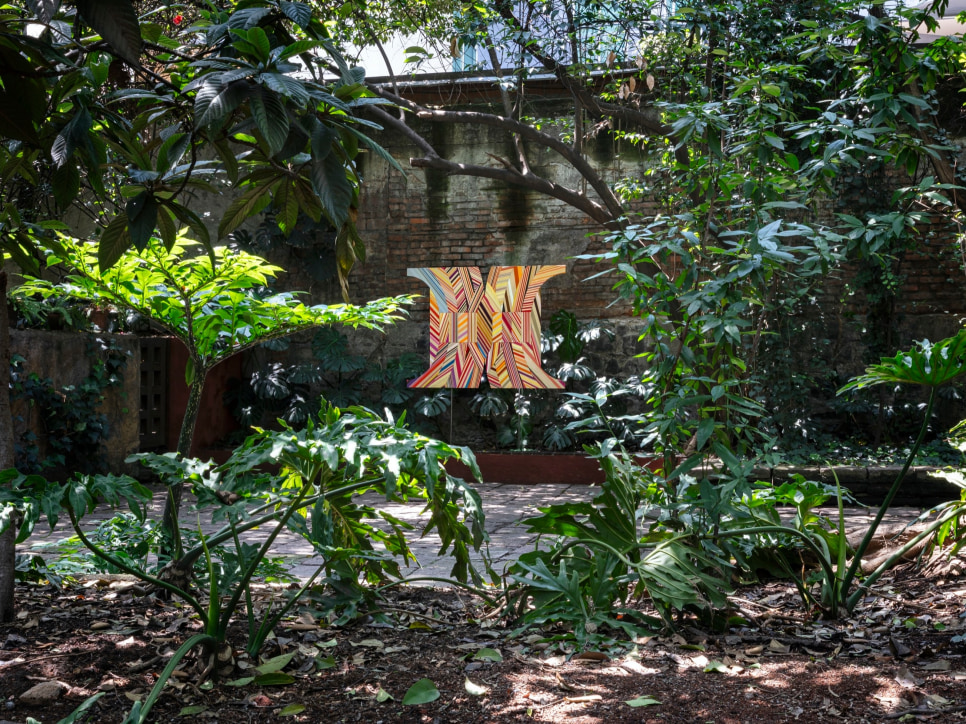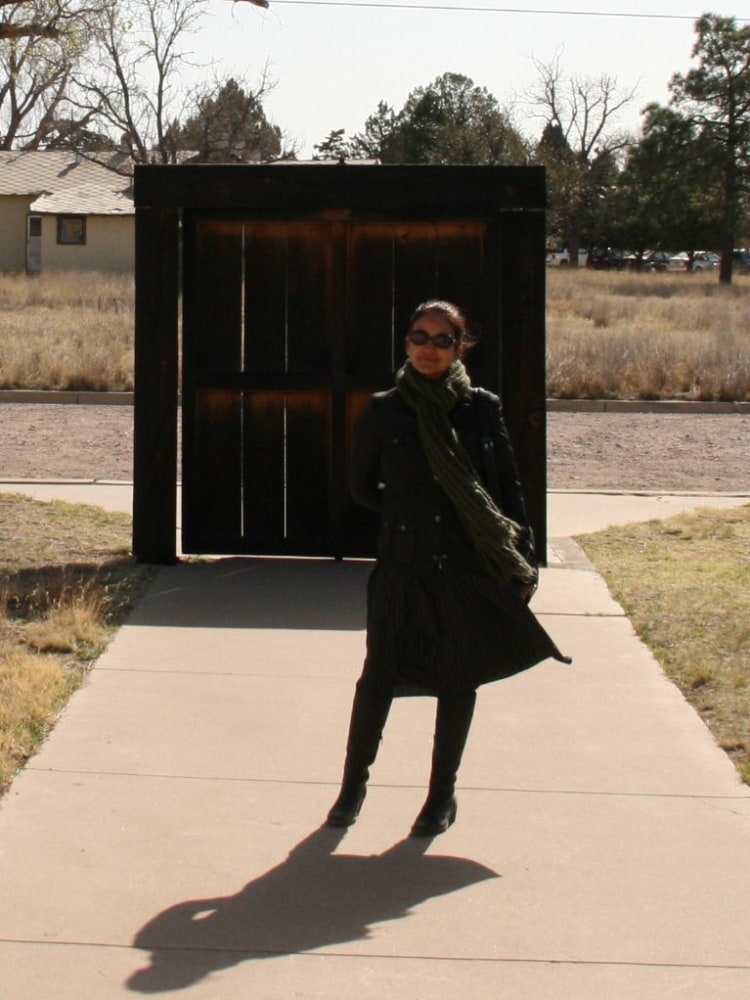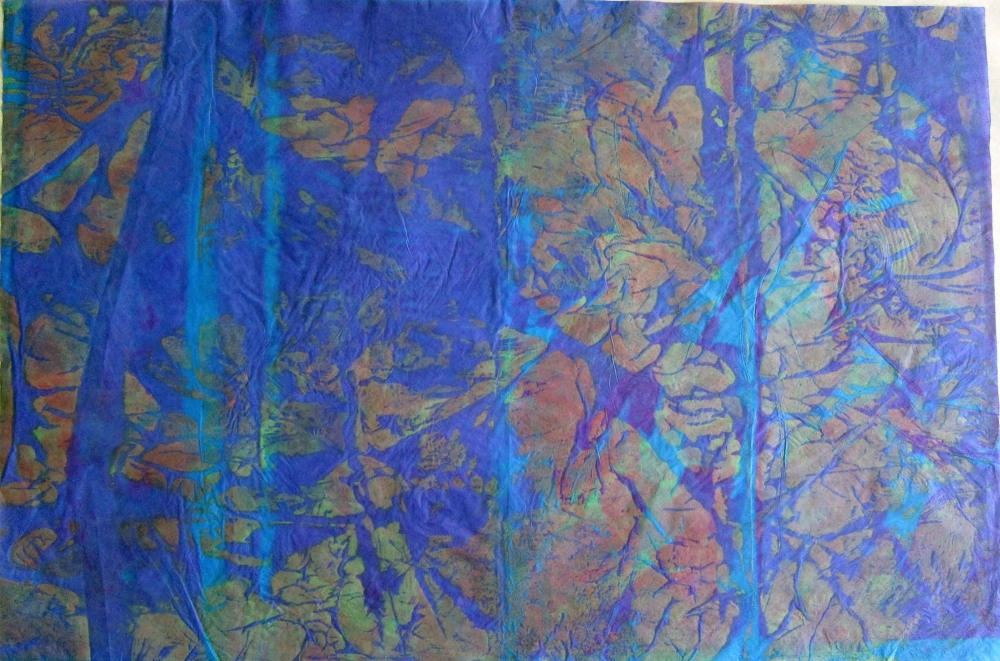

sofía táboas
1968, Mexico City
Sofía Táboas investigates both natural and man-made spaces, examining how they are constructed, transformed, contemplated and perceived. Her interests are evident in the materials she utilizes and activates in her sculptures and installations, including artificial and live plants, mosaics, pool equipment, construction materials, plastic, light bulbs, fire, among others. Her work creates a threshold—a boundary between elements that may appear incongruous or irreconcilable—that serves to redefine the boundaries of the public and the private, the interior and the exterior. Táboas adeptly manipulates space to create interactive structures and contexts where materials can be reinterpreted on new terms. Despite its ostensibly formal sobriety, her work has the capacity to create habitats, such as floating gardens or underwater scenes, and explore new protozoan life, with the potential to alter perceptions, movements, and material attributes. Influenced by the Arte Povera and Neo-Concrete movements, Táboas’s practice might be conceived of as an archeology of the future, where the use of common materials helps bridge the gap that separates us from what lies outside or a distant tomorrow—while enveloping us in the familiar, here and now.
Táboas received her Bachelor of Fine Arts from Universidad Nacional Autónoma de México (UNAM), Mexico City (1986-1990). In the 1990s, she was a founding member of the alternative space Temístocles 44in Mexico City.
Sofía Táboas currently lives and works in Mexico City, Mexico
alberca para muro, 1999
plastic, paper mache, plaster, polyurethane, venice mosaic
alberca para muro, 1999
plastic, paper mache, plaster, polyurethane, venice mosaic
alberca semi-olímpica para muro, 2009
mosaic, plastic
variable dimensions
alberca semi-olímpica para muro, 2009
mosaic, plastic
variable dimensions
azul acapulco, 2000
mosaic, plaster, paper mache
31.5 in. diameter
dorso, 2011
venice mosaic, steel, cement, brick
35.43 x 78.74 x 47.24 in.
cinco jardines flotantes para cinco piedras, 2009
five stones and five floating gardens made out of plastic bins, plastic containers, rubber tires, wood, plastic bags with earth and plants
137.8 in. diameter
installation view at casa del lago, mexico city, 2009
cinco jardines flotantes para cinco piedras, 2009
five stones and five floating gardens made out of plastic bins, plastic containers, rubber tires, wood, plastic bags with earth and plants
137.8 in. diameter
installation view at casa del lago, mexico city
filtro lama, 2011
glass, 180 liters of water, light, algae, plastic
51.18 x 59.06 x 7.87 in.
filtro lama, 2011
glass, 180 liters of water, light, algae, plastic
51.18 x 59.06 x 7.87 in.
detail
filtro lama, 2011
glass, 180 liters of water, light, algae, plastic
51.18 x 59.06 x 7.87 in.
detail
doble turno, 1994
plastic balls, nylon
variable dimensions
installation view at muac museo de arte contemporáneo, mexico city
detail
doble turno, 1994
plastic balls, nylon
variable dimensions
detail at muac museo de arte contemporáneo, mexico city
espejo de agua, 1998
caramel, artificial edible colorant
variable dimensions
emulsión doméstica, 2005
wood, paint, bulb, plexiglass, steel
98.43 x 88.19 x 88.19 in.
emulsión doméstica, 2005
wood, paint, bulb, plexiglass, steel
98.43 x 88.19 x 88.19 in.
filtro ámbar, 2011
acrylic, steel wire, anodized aluminium
variable dimensions
espectro, 1993 - 2011
carpet, wood, engraved metal plate
variable dimensions
espectro, 1993 - 2011
carpet, wood, engraved metal plate
variable dimensions
instrucciones para tejer una flor, 2013
plastic fiber
218.11 x 217.32 in.
fuego enlatado con plan extraterrestre, 2001 - 2011
910 cans of alcohol
variable dimensions
fuego envasado, 2001
600 cans of alcohol on grass
variable dimensions
cosecha espacial, 2005
white neon, artificial plants
125.98 x 110.24 x 1.18 in. each module
expansión cósmica, 2005
aluminiun, acrylic, formica, steel wire
variable dimensions
germen voynich, 2005
wood
variable dimensions
germen voynich, 2005
wood
variable dimensions
jardín portátil, 2001
plants, wooden movable platform
78.74 x 78.74 in.
muro que se desprende, 2002 - 2011
four liters of glue, 20 kilos of glitter
variable dimensions
untitled (méxico), 2001
natural plants, water, nylon, plastic
variable dimensions
personal cage 1, 2013
welded and forged steel, matte black automotive paint
98.43 x 98.43 in.
personal cage 2, 2013
welded and forged steel, matte black automotive paint
98.43 x 98.43 x 98.43 in.
personal cage 3, 2013
welded and forged steel, matte black automotive paint
98.43 in. diameter
personal cage 4, 2013
welded and forged steel, matte black automotive paint
118.11 x 47.24 in.
permeabilidad translúcida (horizontes I), 2010 - 2011
india paper, water
19.29 x 28.74 in.
permeabilidad translúcida (horizontes IV), 2010-2011
india paper and water
19.29 x 28.74 in. each
trébol volcánico, 2006
obsidian
10.63 x 51.18 x 43.31 in.
muro de construcción, 2011
wood, metal, plaster, cement, stone, glass, mirror, ironworks, brick
installation: 78.74 x 188.98 x 7.87 in.; 7.87 x 7.87 x 7.87 in. each cube
muro de construcción, 2011
wood, metal, plaster, cement, stone, glass, mirror, ironworks, brick
installation: 78.74 x 188.98 x 7.87 in. each cube: 7.87 x 7.87 x 7.87 in.
alberca para muro, 1999
plastic, paper mache, plaster, polyurethane, venice mosaic
alberca para muro, 1999
plastic, paper mache, plaster, polyurethane, venice mosaic
alberca semi-olímpica para muro, 2009
mosaic, plastic
variable dimensions
alberca semi-olímpica para muro, 2009
mosaic, plastic
variable dimensions
azul acapulco, 2000
mosaic, plaster, paper mache
31.5 in. diameter
dorso, 2011
venice mosaic, steel, cement, brick
35.43 x 78.74 x 47.24 in.
cinco jardines flotantes para cinco piedras, 2009
five stones and five floating gardens made out of plastic bins, plastic containers, rubber tires, wood, plastic bags with earth and plants
137.8 in. diameter
installation view at casa del lago, mexico city, 2009
cinco jardines flotantes para cinco piedras, 2009
five stones and five floating gardens made out of plastic bins, plastic containers, rubber tires, wood, plastic bags with earth and plants
137.8 in. diameter
installation view at casa del lago, mexico city
filtro lama, 2011
glass, 180 liters of water, light, algae, plastic
51.18 x 59.06 x 7.87 in.
filtro lama, 2011
glass, 180 liters of water, light, algae, plastic
51.18 x 59.06 x 7.87 in.
detail
filtro lama, 2011
glass, 180 liters of water, light, algae, plastic
51.18 x 59.06 x 7.87 in.
detail
doble turno, 1994
plastic balls, nylon
variable dimensions
installation view at muac museo de arte contemporáneo, mexico city
detail
doble turno, 1994
plastic balls, nylon
variable dimensions
detail at muac museo de arte contemporáneo, mexico city
espejo de agua, 1998
caramel, artificial edible colorant
variable dimensions
emulsión doméstica, 2005
wood, paint, bulb, plexiglass, steel
98.43 x 88.19 x 88.19 in.
emulsión doméstica, 2005
wood, paint, bulb, plexiglass, steel
98.43 x 88.19 x 88.19 in.
filtro ámbar, 2011
acrylic, steel wire, anodized aluminium
variable dimensions
espectro, 1993 - 2011
carpet, wood, engraved metal plate
variable dimensions
espectro, 1993 - 2011
carpet, wood, engraved metal plate
variable dimensions
instrucciones para tejer una flor, 2013
plastic fiber
218.11 x 217.32 in.
fuego enlatado con plan extraterrestre, 2001 - 2011
910 cans of alcohol
variable dimensions
fuego envasado, 2001
600 cans of alcohol on grass
variable dimensions
cosecha espacial, 2005
white neon, artificial plants
125.98 x 110.24 x 1.18 in. each module
expansión cósmica, 2005
aluminiun, acrylic, formica, steel wire
variable dimensions
germen voynich, 2005
wood
variable dimensions
germen voynich, 2005
wood
variable dimensions
jardín portátil, 2001
plants, wooden movable platform
78.74 x 78.74 in.
muro que se desprende, 2002 - 2011
four liters of glue, 20 kilos of glitter
variable dimensions
untitled (méxico), 2001
natural plants, water, nylon, plastic
variable dimensions
personal cage 1, 2013
welded and forged steel, matte black automotive paint
98.43 x 98.43 in.
personal cage 2, 2013
welded and forged steel, matte black automotive paint
98.43 x 98.43 x 98.43 in.
personal cage 3, 2013
welded and forged steel, matte black automotive paint
98.43 in. diameter
personal cage 4, 2013
welded and forged steel, matte black automotive paint
118.11 x 47.24 in.
permeabilidad translúcida (horizontes I), 2010 - 2011
india paper, water
19.29 x 28.74 in.
permeabilidad translúcida (horizontes IV), 2010-2011
india paper and water
19.29 x 28.74 in. each
trébol volcánico, 2006
obsidian
10.63 x 51.18 x 43.31 in.
muro de construcción, 2011
wood, metal, plaster, cement, stone, glass, mirror, ironworks, brick
installation: 78.74 x 188.98 x 7.87 in.; 7.87 x 7.87 x 7.87 in. each cube
muro de construcción, 2011
wood, metal, plaster, cement, stone, glass, mirror, ironworks, brick
installation: 78.74 x 188.98 x 7.87 in. each cube: 7.87 x 7.87 x 7.87 in.

Solo exhibitions include: dia cronía, Casa Ortega México, Mexico City (2023); Sofía Táboas: Gama térmica, Museo de Arte Contemporáneo de Monterrey (MARCO), Mexico (2022); and Museo Jumex, Mexico City (2021); Azul extensivo, Museo Universitario del Chopo, Mexico City (2016); Azul sólido, Centro de Arte Caja de Burgos, Spain (2016); Sofía Táboas. Verde Terrestre, Galería Bacelos, Madrid (2015); Piedra principio, Fundación RAC, Pontevedra, Spain (2013); Revisiones. Sofía Táboas, Museo de Arte Carrillo Gil, Mexico City (2011); Cinco jardines flotantes para cinco piedras, Casa de Lago Juan José Arreola, Mexico City (2009); Azul Pacífico, Casa Luis Barragán, Mexico City (2008); Silvestre, Sala de Arte Público Siqueiros, Mexico City (2002), among others.
Past group exhibitions include: TODOS JUNTOS (All Together), kurimanzutto, New York (2022); El cordón umbilical retiniano, Espacio de Arte Contemporáneo (ESPAC), Mexico City (2018); Lugar: contingencias de uso, Centro Gallego de Arte Contemporáneo, Santiago de Compostela, Spain (2017); Post Neo Mexicanismos, Espacio de Arte Contemporáneo (ESPAC), Mexico City (2016); Strange Pilgrims, The Contemporary Austin, TX (2015); Strange Currencies. Art & Action in Mexico City 1990–2000, The Galleries at Moore College of Art & Design, Philadelphia, PA (2015); Gares & Connexions, FRAC Bourgogne, Dijon, France (2013); Panorámica 2013–1969, Palacio de Bellas Artes, Mexico City (2013); Play with me, Museum of Latin American Art (MOLAA), Long Beach, CA (2012); Recent past: new acquisitions at the Museum of Contemporary Art, The Museum of Contemporary Art (MOCA), Los Angeles, CA (2011); Superficies del deseo, Museo Universitario de Arte Contemporáneo (MUAC-UNAM), Mexico City (2010); Edén, Antiguo Colegio de San Ildefonso, Mexico City (2003); Siete dilemas: Diálogos en el arte mexicano, Museo de Arte Moderno, Mexico City (2002), among others.
Two complementary exhibitions present the work of Sofía Táboas at the Jumex Museum starting on October 7, 2021.
Both explore the relationships between human and natural forces: Thermal Range does so through her individual trajectory and Ambient Temperature through the perspective she has on the work of her contemporaries.
Eduardo Abaroa, Sofia Táboas and a group of mexican artisans collaborated to mold and carve a collection of 53 sculptures of different dimensions, whose shapes correspond to plants, roots or animals, such as mandrakes, insects, birds-dolphins, flowers of different types, peyotes, artichokes, nopales, avocados, trees, sheep-dogs, scorpion worms, branches, a flying saucer, among many more at Museo Amparo in Puebla.
Listen Sofía Táboas' Spotify playlist Voces Agridulces.
